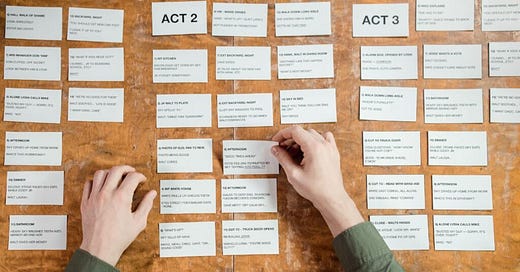Writing B Plots for Unforgettable Arcs
Already built a solid main plot for your story? How about the B plot?
If your side characters feel flat or your pacing drops halfway through, it's probably because your B plot isn't pulling its weight. But here's the good news: fixing it doesn't mean rewriting your whole story. You just need to give that B story some purpose, and maybe a little help from ChatGPT.
What Is the B Plot?
The B plot is the secondary storyline that runs alongside your main story (aka the A plot). And yes, it's not the star of the show, but it matters. In fact, it's often where readers fall in love with your characters.
But, is there any difference with the A plot? Oh, yes!
The A plot is the primary event; the big goal, the conflict, and the "will they win or lose?" On the other hand, the B plot is the supporting act. It's what adds flavor, emotion, and breathing room to your story. And no, the B plot is not the same as a subplot. All B plots are subplots, but not all subplots qualify as B plots.
Here's how to spot the difference:
A plot = Protagonist vs. Antagonist
B plot = Usually a relationship, theme, or side quest for character development
A plot = Moves the story forward
B plot = Adds emotional depth, tension, and resonance
A plot = The what
B plot = The why we care
For example
In Harry Potter, the A plot is defeating Voldemort. The B plot? Harry's relationships with Ron, Hermione, and his mentors.
In a rom-com? The relationship is often the A plot, while a work promotion or family drama might be the B plot.
What Is the B Plot for?
If you're struggling to figure out what your story's heart is, it might be time to zoom in on your B plot. So, what's the point of a B Plot?
Well, let's see:
Gives side characters a moment to shine
Explores themes without preaching
Let your protagonist grow in ways the A plot can't
Breaks up the action and gives your pacing some breathing room
Adds emotional weight; yes, we want the hero to save the world, but we also want them to apologize to their sister.
So, think of the B plot as your story's wingman. It's not there to steal the spotlight; it's there to make your A plot shine harder.
It shows what your characters are like when they're not fighting the main battle.
For example, maybe they're totally focused on winning the competition, but their B plot (like repairing a friendship or realizing they don't need external validation) is what actually transforms them.
The B plot is where the internal change sneaks in.
B Plot Examples
Still feeling fuzzy on what a B plot actually looks like?
Let's clear it up with some familiar films. These examples show how the B story supports, deepens, or contrasts with the main storyline, without stealing the show.
The Lion King
A plot: Simba's journey to reclaim the throne.
B plot: Timon and Pumbaa teach Simba to forget the past, which ends up shaping how he faces his future.
Back to the Future
A plot: Marty is trying to get back to 1985.
B plot: Marty helps his awkward teenage dad stand up to Biff and win his mom's heart.
The Hunger Games
A plot: Katniss is fighting for survival in the arena.
B plot: Her complicated relationship with Peeta—real feelings or just part of the act?
Legally Blonde
A plot: Elle proves she belongs in law school.
B plot: Elle realizes she doesn't need Warner or anyone else's approval to succeed.
The Dark Knight
A plot: Batman is trying to stop the Joker's chaos.
B plot: Harvey Dent's rise and tragic fall, which mirrors Bruce's own moral tightrope.
Using ChatGPT for Your B Plot
We get it, sometimes the struggle with the B plot is real. Secondary storylines can be slippery, especially when they're supposed to support the main plot without stealing the show.
The best news? ChatGPT is surprisingly good at helping you sort out the mess, find new angles, or even create a subplot from scratch. This writing partner never runs out of ideas (or gets tired of hearing you talk about your characters).
Have B Plot Characters
B plot characters aren't just sidekicks. They're the reason your main character actually grows and transforms.
Many think that the B plot was just a bonus storyline. But the truth? It's what gives the A plot emotional weight.
Here you have a few perks of the B characters.
They challenge the main character's worldview.
They show a different way of living.
They help bring the theme to life.
Think Dory in Finding Nemo. They're not the star, but they shape the story's heart.
And these are some things they should be packed with:
Goals: They should want something, have their own stakes. They're not just there to cheer the hero on.
Conflict: Give them something to fear, and a belief they need to question.
Growth: This comes with a change they're resisting. Eventually, their transformation is what triggers your hero's.
Here's the prompt:



